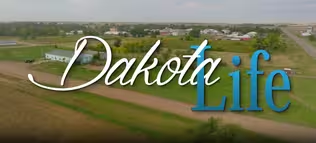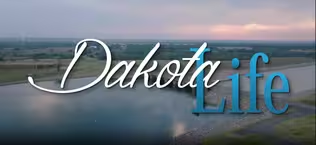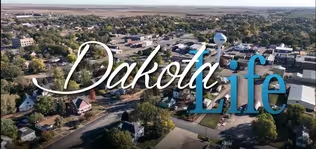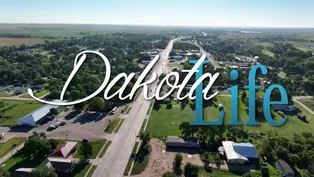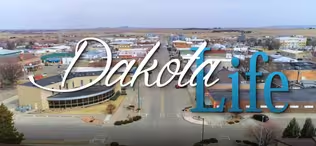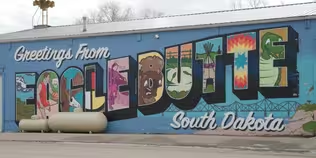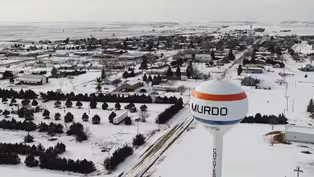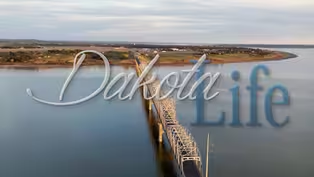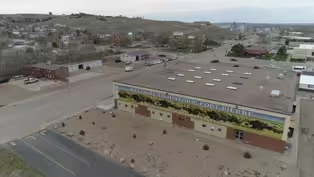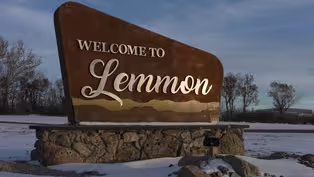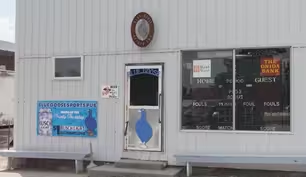Dakota Life
Greetings from Onida
Season 26 Episode 2 | 27m 18sVideo has Closed Captions
Onida is home to a ranching family, a salmon fisherman, and a memorabilia collection.
An Onida ranch family discusses their multi-generation legacy in farming. Plus, meet a woman who goes on old west-style wagon trains and a man who fishes for salmon in Lake Oahe. A sports bar in Onida is home to a large collection of high school sports memorabilia.
Problems playing video? | Closed Captioning Feedback
Problems playing video? | Closed Captioning Feedback
Dakota Life is a local public television program presented by SDPB
Support Dakota Life with a gift to the Friends of Public Broadcasting
Dakota Life
Greetings from Onida
Season 26 Episode 2 | 27m 18sVideo has Closed Captions
An Onida ranch family discusses their multi-generation legacy in farming. Plus, meet a woman who goes on old west-style wagon trains and a man who fishes for salmon in Lake Oahe. A sports bar in Onida is home to a large collection of high school sports memorabilia.
Problems playing video? | Closed Captioning Feedback
How to Watch Dakota Life
Dakota Life is available to stream on pbs.org and the free PBS App, available on iPhone, Apple TV, Android TV, Android smartphones, Amazon Fire TV, Amazon Fire Tablet, Roku, Samsung Smart TV, and Vizio.
Providing Support for PBS.org
Learn Moreabout PBS online sponsorshipMore from This Collection
Dakota Life stories from towns in central South Dakota
Video has Closed Captions
In the heart of the Standing Rock Indian Reservation, we discover McLaughlin. (29m 29s)
Video has Closed Captions
We travel to Burke and introduce you to a writer, an artist, and the twins of Franklin Street. (29m 50s)
Video has Closed Captions
Timber Lake celebrates its heritage in July with the Days of 1910 activities. (29m 41s)
Video has Closed Captions
Uplifting culture of the Dakota Oyate on the Crow Creek Reservation. (29m 17s)
Video has Closed Captions
Dakota Life travels to the community of Mission. (29m 34s)
Video has Closed Captions
Winner has great baseball, theatre, and local authors and is a sportsperson's paradise. (27m 25s)
Video has Closed Captions
Dakota Life visits the community of Eagle Butte (26m 58s)
Video has Closed Captions
Fort Pierre is our host community this month for Dakota Life. (28m 36s)
Providing Support for PBS.org
Learn Moreabout PBS online sponsorship(upbeat music) - [Announcer] This is a production of South Dakota Public Broadcasting.
(upbeat music) - When the first European explorers crossed the middle of North America, they beheld a sea of grass.
Those white explorers had never seen anything like it.
They didn't even have a word for it.
The French described it as, "A meadow."
The English called it, "The prairie."
And if a census had been taken about that time, it would've reported about one person for every 5,000 acres.
Native peoples were nomadic.
They lived off the land, hunting the vast herds of bison, antelope, deer, and elk.
Now, the Homestead Act of 1862 changed all of that.
The US government claimed ownership, and opened the lands to the west to settlement.
Settlements were followed by towns, towns by counties, and one of those counties near the center of South Dakota was named after a Civil War officer and painter, Alfred Sully.
The western boundary line of Sully County is defined by the Missouri River.
The county seat was founded in 1880, by settlers who were originally from Oneida, New York.
It's nestled in the heart of South Dakota, it's Onida and has a population now of around 700.
It's known by its warm hospitality, fascinating history, and breathtaking natural beauty.
Onida is kind of a hidden gem, rich in Native American history.
The Onida Historical Society Museum showcases artifacts and exhibits that tell the story of Onida and its pioneers.
Onida has a strong sense of pride and brings residents together with a variety of events throughout the year.
For instance, the Onida Rodeo includes barrel racing, bull riding, and all of those great familiar rodeo events, along with live music, food, and other traditional cowboy activities.
Now for context, we're about 30 miles northeast of Pierre.
Here in Onida, the main street is lined with locally-owned businesses, antique shops, and cozy cafes.
Nearby, growers offer up farm to table options, and you can savor fresh produce straight from the fields.
There's a genuine friendliness from the people, who enthusiastically are waiting to share their stories.
And that is what we're here for.
Welcome to "Dakota Life", and greetings from Onida.
(upbeat music) - [Announcer] This program is made possible with support from our members.
With corporate support from BankWest.
For more than 130 years, Bankwest has built a reputation for helping customers and communities succeed.
With their roots firmly planted in South Dakota, BankWest associates provide financial services backed by hometown values.
And by Ringneck Energy.
With a mission to produce low carbon renewable energy, and to create economic opportunities, more about selling corn, buying distillers, and employment can be found at RingneckEnergy.com.
- Like many other communities in South Dakota, railroads have played a vital role.
Not only in settlement but in growth too.
Railroad companies even recruited homesteaders to this area as far away as Europe.
They also mapped out towns for the new arrivals to live in.
That practice goes back to the early 1860s, when Dakota territory lawmakers chartered the first railroad companies.
The Onida Subdivision is a branch line railway.
It's a segment owned, maintained, and operated by the Rapid City, Pierre, and Eastern Railroad.
Now that line connects Onida to the main East-West line at Blunt, about 17 miles southeast, along Highway 14.
And altogether, that connects Onida to the rest of the world by rail, providing a way for the local ag producers to transport their crops off to market.
While the ag production further east focuses mainly on corn and soybeans, here in Central South Dakota, cropland is often dominated by sunflowers.
So much so that South Dakota is the number one sunflower-producing state in the nation.
Coming up, we're going to see memorabilia at The Blue Goose Sports Bar.
We'll put out a line and see if anything's biting to the west over at Lake Oahe, and we'll meet someone known for playing the accordion, building wagons, and teaching kids archery.
But first, let's get back to Onida as the center of the sunflower-producing world.
Now the Yackley family and Yackley Ranches are five generations strong.
The third generation includes Todd Yackley.
He's in charge of all the crops, including those sunflowers.
(soft music) - It's the only way it works in Central South Dakota.
To raise a good crop, is it has to be no-till, and most of the time, it's gotta be behind wheat.
- [Larry] We'll get to those sunflowers in just a moment, but you've just heard Todd Yackley, who oversees crop production for Yackley Ranches, give you two of the three components to growing good crops around Onida: crop rotation, or planting wheat one year, followed by a different crop in that field the next, and no-till, or not plowing up the soil after harvest or before planting the next year.
- It's just been a game changer for us.
Sometimes our fields, we get so much residue in 'em, you know, sometimes they're hard to plant or get planted.
You gotta wait for the right conditions and the right day to get out there and plant.
But our corn might not look the best as the neighbor's corn that that was done with tillage or whatever.
He said, well, you don't combine corn in June.
You know, just wait till July, August, you know?
And typically the no-till, that's where it shines.
'Cause we get dry and hot in July and August, and that extra moisture will just make a crop for us.
(soft music) - [Larry] The wheat stubble left behind at harvest catches snow all winter, and acts like a mulch to retain moisture when the next crop grows in around it.
That third component to good crops, besides getting rain, is having a dependable and drought-resistant crop to plant.
That's why we're standing in a field of sunflowers.
- This is the first field that we planted, probably the 26th or 27th of April.
And I would say, I'd say by the first of October, we're probably gonna be harvesting it.
All these leaves will be off at harvest time.
So basically it'll just be the head here.
So hopefully they're all standing nice.
We can come in here and clip and leave them knee-high, let that catch snow all winter.
And we plant spring wheat in it to next year.
(soft music) One problem that we've been battling the last two or three years is the seed weevils.
There's a lot of sunflowers grown in our area, and we're getting resistance to the seed weevil, which you can probably see inside of these heads.
Like, here's one here, is a red seed weevil.
And what they'll do is they'll bore into these seeds, and they'll lay eggs, and they'll hatch, and then there just gets to be more and more of them.
- [Larry] If all goes well, some sunflower varieties in South Dakota go to the confection market.
They soak in brine, and we might enjoy eating them during a ball game.
The Yackleys grow sunflowers that will be crushed for cooking oil, or sold to bird food producers.
- [Todd] About all of our bird stuff that goes to bird seed.
We have a really good relationship with Pennington Seed, and they're out of Missouri and Georgia.
Their trucks come to our farm and pick up our flowers.
So this, like this crop will be harvested in October, November.
Some of these might not leave until the following October, November, depending on what type of contracts we do with them.
- [Larry] Todd is part of a third generation of Yackleys on this land, and the next two are already involved in the family business.
- We like to just keep progressing.
We want to keep being good at what we do, and we wanna teach our kids, teach our grandkids how we did it, and hopefully they can leave the land better than what they took it over for.
(soft music) - Sully County is a beautiful place to visit, and people will tell you, this is a great place to raise a family.
Onida and surrounding towns know that a strong work ethic will help build your business, but it also pays off at State Tournament time.
The Sully Buttes Chargers have been a powerhouse at Class B sports tournaments over the years.
With athletes from Agar, Blunt, and Onida, they boast a rich tradition of sports.
Now, Joe Mandel, a charter member of the South Dakota Sports Hall of Fame, set school records in the 1920s.
Matter of fact, in 1926, he accomplished what no other South Dakota athlete had done.
Back in the high school one classification days, Joe single-handedly won the state track meet.
He entered four events and won them all, and earned enough points by doing so that Onida edged Sioux Falls, Washington 20 to 19.
Former Summit League Women's Player of the Year and USD basketball standout, Chloe Lamb is from Onida, as our two PGA golfers of renown: the brothers Tom and Kurt Byrum.
Originally from Onida, both have excelled in PGA tournaments and the Champions Tour too.
South Dakota communities seem to always have an unofficial gathering place, and they often revolve around sports themes.
Here in Onida, that place is The Blue Goose Sports Bar.
It's home to an amazing collection of sports memorabilia and it will take you on a trip through Central South Dakota Sports history.
(soft guitar music) (wind whistling) - Welcome to The Blue Goose.
(soft piano music) Jamie Lamb said, "When you do this bar, "you gotta name it The Blue Goose."
'Cause everybody called this old bar in town The Blue Goose, and that was its nickname.
And I said, "Let's do it."
We ran with it.
We were kind of searching and it worked, I guess, so...
It started really simple.
The four of us came together.
We were just gonna kind of have a clubhouse, and we got a liquor license, and I had all this stuff that I've been collecting for years, and I said, "Let's throw it on the walls and see what happens."
And I'm officially the first non-smoking bar in South Dakota.
When we opened it, we went non-smoking, which is kind of cool.
It was before the law went into effect.
But people come in, they feel like they're at somebody's basement or a garage or somewhere with all this stuff, and they walk around, and there's memorabilia from all over the state.
So get a lot of old schools and things aren't even, schools that aren't even, no longer have schools, they're co-ops now, you know?
And that's some of the stuff we really like.
Mobridge football jersey, Broncs, you know, every imaginable side of the state, people bring in.
People come in and they, they can really relate to, you know, "Can you believe they wore that short of shorts?"
Or that jersey material or whatever, you know?
And I've been in the sporting goods world for 30 years selling colleges and high schools.
And so it's kind of a, it's a passion for me.
I love collecting old stuff like that.
And people come out of the woodwork and bring us stuff.
We have a scoreboard donated by the Biel boys outta Java.
Brown Trucking, the independent basketball, lots of old memorabilia, and then helmets, you know?
We have a lot of great selection of helmets that have come, and ranging from old leather helmets up to modern-day stuff.
Oh, just like any kid, you started with sports cards, and you know, you bought, sell, trade.
And my wife and I collect antiques, and everywhere I went, I was always finding sports, old sports stuff, leather helmets and things.
And I just, I was kind of enthralled in it.
I just kept collecting, kept collecting.
And the Tim Miles jersey right back there Doland High School, I didn't know I had it.
Tim's a good friend of mine.
He went to college with my wife at University of Marion Bismarck.
And we're having supper, we went to supper with him at the Cattleman's.
We're sitting there, I said, "Tim, what was your high school number?"
And he said, "32, 33."
So I called the bartender, I said, take a picture of that Doland jersey.
I show it to him, and he goes, "That's my high school jersey."
I got a lot more stuff.
There's more to come.
I've talked with a couple buddies, we've talked about possibly expanding if we can find the right town, to another Blue Goose out there somewhere, and spreading what we have here into another small town, if things would work out right.
(soft music) You know, Onida is so rich in tradition of state championships, you know, and having good sports teams, you know?
So after sports events, there's people that come down, they want to talk sports and the games.
And you know, we have a lot of people in the area that come down here.
Even if they're from the other towns, wanna stop and have a pizza and a beer after the games and talk sports.
And a lot of people gravitate here and they say, "Hey, I gotta see The Blue Goose.
"I heard about this."
Or, you know?
And it's so rich in tradition and it's a town that you know, lives and dies on athletics.
(soft music) - For over 60 years, the annual Sully County Snow Queen competition invites freshmen and senior girls to vie for the title and to represent Onida at the state Snow Queen Festival in Aberdeen.
The winners are selected based on interview, personality, and community involvement.
Right now we're about five miles west of Onida at Sully Lake.
Another 15 or so west, and you're at the Missouri River, at Lake Oahe.
That lake was created as part of the Pick-Sloan plan that dammed the river in the fifties.
The construction created Lake Oahe, but it flooded significant parts of Standing Rock, Cheyenne River, Crow Creek, and the Lower Brule reservations.
Some call it the single most destructive act ever perpetrated on any tribe by the United States.
The plan has created reservoirs, though, it helps with flood control, irrigation, and power generation.
And while it's changed wildlife and fish production, the lakes have created new recreational opportunities.
Oahe is a Lakota word, meaning foundation, or something to stand on.
Today, Lake Oahe is the fourth largest reservoir in the country, and draws nearly 2 million visitors annually for recreation, and to try their luck at catching a walleye, lake trout, northern pike, catfish, sturgeon, and many others, including a non-native species.
That's the Chinook salmon.
So let's cast out a line and see what happens.
(intense drum music) - [Kate] As the sun rises over Lake Oahe, a new day of fishing is already underway.
And Kevin Thibodeau is setting his lines as deep as 80 feet with one goal in mind: salmon.
- I am very obsessive when it comes to the salmon fishing.
It's almost a disease.
My mind is always, always going.
And 95% of the thoughts are salmon fishing.
- [Kate] Those thoughts of salmon have been swimming around his brain for decades, eventually landing him in Onida.
- Oh, I've been fishing my whole life.
When I was growing up in northern Minnesota, my dad used to take us over to Lake Michigan for a week every summer.
And that's kind of where I got my start and passion for salmon fishing.
Sometime in the late nineties, got into the salmon fishing on Oahe.
And I had salmon fished for several years out here prior to starting the guiding, and I had never seen any of them guiding for salmon.
It appeared to be a hole that needed to be filled.
- [Kate] In 2023, Thibodeau began salmon guiding full-time, often launching his boat at 5:30 in the morning, and sharing the thrill of the catch with his clients all day long.
- Yeah, I kept seeing him through the water and he'd kind of come up and like, splash the surface.
And I'm like, this thing, this is awesome.
- There is no fresh water fish that fights like a king salmon.
And in addition to that, for me, the type of fishing, the style of fishing, the trolling with the down riggers, and long lines, and divers, it's just a completely different thing than anything else that you would experience in this area.
- [Kate] Back on land, the most colorful parts of fishing comes to life with the stroke of an airbrush.
- Early this summer, the bite was extraordinary.
It was unusually good.
And 90% of what I caught fish on was my own spoons.
That was very rewarding.
- [Kate] The designs are always evolving, tailor made to what brings the most luck out on the water.
- [Kevin] You know, if I hear somebody's catching fish, on something I don't have, there's a fair chance I can come home and I can make one real quick, and I can have it the next day.
- [Kate] When the fish aren't biting, it takes a balance of patience and ingenuity, switching out lures and even the speed of the boat to get a bite.
The moment a salmon is on the line makes it all worthwhile.
- [Kevin] Taking somebody out who's never experienced salmon fishing before, and being able to see that individual reel in sizable salmon, something that's really gonna put up a good fight, pull a lot of line.
Whoa!
(Kevin laughing) Little one?
(men laughing) That thing is huge!
- [Fisherman] Wow.
- [Kevin] The look on their face when that fish in their hands is, it's priceless.
It's very rewarding for me, especially kids.
Fishing in Oahe is, it's tough fishing, or it can be.
It can be very tough.
Things don't always work out the way they're supposed to.
But if every client on the boat gets the opportunity to reel in a fish, it's a success for me.
- [Kate] Successful fishing trips can't always be measured in inches and pounds.
Sometimes it's the memories that mean the most.
- You know, even before I was hardcore into the salmon fishing and fishing walleyes and stuff, I would still be out here and have poor fishing, and then I would, you know, me and my dad would be fishing, and I'd look at my dad and I would say, "You know what?
"I'd rather have poor fishing out here "than good fishing back east."
A lot of the lakes back east, you know, they're just so developed, and that's definitely not the case on Oahe.
It's just a lot of big country, wide open.
(upbeat rock music) - Onida is just east of the river, but it has plenty of Western feel.
Each year, the South Dakota High School Rodeo finals feature not only competitors from this area, but also the livestock.
You see, Onida is the home to Sutton Rodeo, a multi-generational family business, run by a member of the Pro Rodeo Hall of Fame.
Jim Sutton Junior and his wife Julie were elected to the Pro Rodeo Hall of Fame in 2020.
Jim is the patriarch of the Sutton rodeo family, and he and his business are well-known to participants and fans alike.
Sutton Rodeo has won a multitude of awards, and their stock has been selected to perform at the National Finals Rodeo every year but one since that rodeo's inception in 1959.
Now as far as Western personality, let's meet Jane Brehe.
She's a farmer and rancher by trade, but she also plays the accordion, builds wagons by hand, and teaches archery to area kids in Sully County.
She once spent three months on a trail ride, in a wagon her family built, and with her grandson leading the team.
Each December, her family gives rides in their covered wagon.
We thought you'd like to meet her, so we caught up with her on one of her most favorite places.
Of course, it's a trail ride.
- [Greg] Since 1989, the sights and sounds of the trails have captivated Jane Brehe.
- My husband said, we're gonna go on that wagon train.
And I looked at him and I go, "A wagon train?
"Really?
"It's three months long."
"Yeah, we're gonna go."
It was the best summer we ever had.
- [Greg] For the Brehe family, three months was a long time to be away from the family farm.
- But it turned out, we dried out that year.
There wasn't nothing to do.
The crops dried out.
Our nephew came and helped Grandpa take care of the Angora goats, because we had Angora goats at that time too.
And watched the goats, and took care of what little farming there was.
And we were able to go.
- [Greg] Wagon Trains mean an escape from the present day for the Brehes.
There are no electronics on this trip back in time, where at night, people actually meet in person, and enjoy the same entertainment their forefathers did.
(Jane playing accordion music) - You know, we'd have guitar players at the wagon trains, but not a lot of them.
And then I got to thinking, the accordion was something, one of my desires.
I had two that I wanted to learn: how to tat and learn how to play accordion.
So I finally learned how to tat, and then it was time to learn how to play accordion.
Everybody loves it.
And you get people singing and dancing, because I play long songs, like "Row Row Your Boat," and, "There's a Tavern in the Town."
And some of those old songs that we all learned, at least we all learned in grade school.
I know younger people probably don't.
But the ones that are on these wagon trains learned them in grade school.
- [Greg] Jane and Dale Brehe became wagon train regulars across the Midwest up until 2014, when Dale's health began to fail.
- [Jane] My husband passed away in November of 2014.
Which was the wagon train we were on.
We got partway through the wagon train, and he was driving the bus, and little things were happening, and he was getting forgetful and things.
And it was to the point that the one night we came home, and he didn't even ask how the horses were.
And when he didn't ask about taking care of the horses, I knew something was wrong.
So we went to the doctor that night, and that's when they sent us to Sioux Falls and found out he had cancer.
- [Greg] With Dale gone, Jane took a break from the trail rides, but soon she felt the familiar call and decided to return.
But first, she had a little bit of convincing to do.
- It was hard that first time.
And my horses decided they didn't wanna load.
One of the horses decided that if Dale wasn't there, they weren't gonna get in either.
It took us a lot longer to load the horse.
And the only thing we could figure out is, they wouldn't follow me in the horse trailer, because it was always Dale let 'em in and I shut the gate.
And yeah, so, it got so that Mickey could lead him in, and then we could go and the wagon train went.
We had a good time.
- [Greg] Jane's return to the trail also means her skills will be passed on to the next generation.
- Okay, girls.
- Okay, girls.
- Get up.
- Get up.
- Go.
Mickey wanted his son Axel to be able to learn how to drive too, so that's our plan, and we're gonna try and hit some more wagon trains this way.
So it just means a lot that we can carry this on, because Dale's dad kind of taught us how to hook the horses up to begin with.
Dale was a cowboy, but his dad taught us more about the hitching.
And then now we get to teach Mickey and my daughter.
My daughter and other grandkids get to come too.
And then now we get to see Axel.
(soft music) Come on.
(soft music) - One of the biggest annual events in Onida every August signals that summer is ready to give way to a new school year.
It's the Sully County Fair.
Planning kicks off in February with a chili cook-off fundraiser.
People around here call it the biggest little county fair in the world.
Along with the rodeo, exhibits, and carnival rides, the Fair also serves as an unofficial reunion for area residents who have moved away, but want to return and celebrate Onida.
You can celebrate too.
Bring your golf clubs, bring your fishing rod, or maybe your desire to experience a little farm and ranch lifestyle.
Bring it to Onida.
Enjoy the sunflowers too, while you're here.
You can see even more stories from around here on our website, along with stories from all of the other communities that we visit all around South Dakota.
And if you want to share those stories with a friend, it's easy to do.
It's all at SDPB.org/DakotaLife.
Thank you for watching from Onida and Sully County, and amidst the sunflowers, I'm Larry Rohrer.
For all of us at SDPB, thanks for coming along for the ride.
(soft country music)
Clip: S26 Ep2 | 7m 11s | The Blue Goose sports bar in Onida has become a staple. (7m 11s)
Providing Support for PBS.org
Learn Moreabout PBS online sponsorshipSupport for PBS provided by:
Dakota Life is a local public television program presented by SDPB
Support Dakota Life with a gift to the Friends of Public Broadcasting


